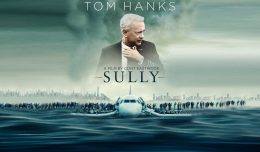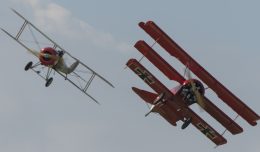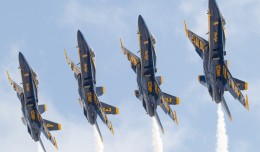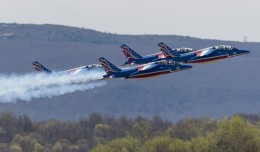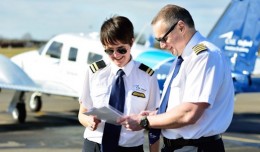Fornof and the BD-5
In addition to the air show routine, Fornof flew the BD-5 in multiple sequences of several films in the James Bond series. For the opening sequence of “Octopussy,” he landed the BD-5 on a highway. In “License to Kill,” he flew the jet through a hanger.
“The BD-5 and I have been through a lot,” Fornof said.
Moonraker was the first Bond movie on which Fornof worked and producers Michael Wilson and Cubby Broccoli, now good friends of his, asked about using the BD-5.
Plans were put in place, but eventually scrapped when a natural phenomenon forced their hand. Two movies later, however, the BD-5 was called upon again, this time making its 007 debut in Octopussy.
To understand the inspiration for the 1983 sequence, Fornof had to explain an earlier incident with the BD-5. On a flight from Atlanta to Washington D.C., at 14,000 feet, he got an oil light.
“It’s got a dual system on there so as long as it was indicating pressure on there I thought I was OK,” he said. “About five seconds after the oil light came on, the oil pressure just dropped to zero, so I reached over and shut the engine off.”
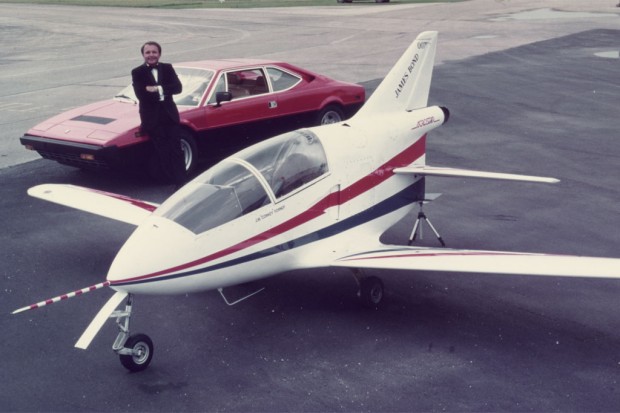
Corky Fornof and the BD-5 on the set of the James Bond classic Octopussy.
Because the BD-5 had so little drag, it made an excellent glider. He made use of the convenient design feature while turning south.
“What had upset me, was we didn’t have the weather information we have today,” he said. “Everything was predicted to be clear but under me was a solid overcast. So I called Center and turned around south because I knew if I stayed on this one certain radio, it’d keep me out of the mountains. This overcast wasn’t supposed to be thick. Well, the overcast lasted until I was 800 feet over a pine forest.”
Fornof said he spotted Interstate 95 about a mile to his right and decided to head that way. The speed limit was 70 mph and he was holding 90 knots when he approached a Mayflower moving van.
“I wasn’t sure I was going to get past it, but the road’s going up and I’m just kind of following the road,” he said. “I actually thought of landing on top of it because when I crossed him, there was maybe only a 10-mile-an-hour difference, but I instantly saw signs of the Roadrunner and him going under an overpass. So I decided against that and I crept in front of him and then I dropped down right in front of him so he’d see me. He blew the horn and started slowing traffic down for me.”
Fornof landed while traveling up one of the humps in the road, passing a Cadillac. He said the people in the car just looked at him.
“As I crested the hill and started down the other side, there was a pickup truck towing a boat,” he said. “The lady in the pickup truck saw me and I could see her talking a mile-a-minute to her husband. As I got up alongside of him going downhill, he just looked over and waved to me. I pointed over in the front. He kind of backed off and I pulled into the right lane. Down at the bottom of this hill was a turnoff to the access road.”
Fornof coasted down the road to a Sunoco gas station, running over the rubber hose and sounding the proverbial, “ding-ding, ding-ding.”
“I stopped right there,” he said laughing. “About this time the owner of the station is leaning up against the door and he’s chewing tobacco and he spits. We looked at each other for a good 20, 30 seconds. He finally walks over to the airplane and I open the canopy. He says, ‘This is Candid Camera isn’t it?’ I said, ‘Nope.’”
There was a dress shop in the strip mall where the gas station was located and Fornof said two ladies, who had just seen him appear on the Mike Douglas show, came running toward him.
“They’re cheering and jumping up and down,” he said. “(The station owner) runs in and gets on the phone and tries to call the TV station. They thought he was drunk.”
One station did eventually call back, Fornof said, but only to relay the information provided them by the Sheriff’s department, that there was no record of a jet crashing on the highway.
Fornof said, “I’m standing right next to him and he says, ‘No, no, no. A jet didn’t crash. It’s this little biddy jet. He landed on the highway and came into my gas station.’ They were sure he was drunk and they hung up.”
Though no TV stations took the matter legitimately, a newspaper did make the trip and took a photo of Fornof standing in front of the BD-5 parked at the station. Fornof eventually reinvented his interstate diversion as the opening sequence of “Octopussy.”
Perhaps his most famous use of Bede’s jet, however, was in the Bond film License to Kill, where he flew through a hanger. His famous flight began with one of the stunts he flew in a commercial for Toshiba. Fornof had been asked to arrive at the meeting with Toshiba prepared with ideas for using the jet, but because he believed the entire event was a friend playing an elaborate practical joke, he didn’t prepare anything. On the spur of the moment, he blurted out the idea of flying the BD-5 through a hanger.
“I instantly realized I let my alligator mouth overload my canary ass,” he said. “But they loved it. So I sat there thinking, ‘Well, OK. We can do it. We can do it.’”
Fornof got a hold of the FAA and requested a waiver to fly through the hanger.
“They laughed and laughed and I laughed with them,” he said. “They said, ‘Now what do you want?’ And I said, ‘I want to go fly through this hanger. I’ve got the owner’s permission and this is what we’re going to do,’ and they gave it to me.”
After securing the waiver, Fornof turned his attention to the physics of flying the stunt. He found out later, through accident reports and the FAA, numerous people had crashed attempting the feat. But Fornof was determined and upon consultation with a close friend, became aware of an essential component to success — proper speed.
“There’s one important key,” Fornof said. “Chuck Sewell was the chief engineering test pilot for Grumman. They were flying a prototype F-14 at the time, and of course they had computers — not like now where everybody has them — and I called Chuck and I said, ‘Chuck, here’s what I talked myself into. I need your help. What’s going to be a safe speed to go through that hanger?’ Chuck said, ‘OK Corkey, I remember the P-51 story.’”
The story to which Sewell was referring began at 10,500 feet over Lake Pontchartrain in New Orleans. Fornof had a friend in the back of his P-51 who suggested they fly under the I-10 bridge. Fornof said it sounded cool, and entered a big split S.
“I pulled it through and I got it lined up at just about red line at 500 miles an hour,” he said. “Flying under the bridge was no big feat. The bridge sits about 20 feet off the water and we were going through one of the humps so you had about 30 feet, but it’s still awful small at that speed. I figured you want to be going as fast as you could, just in and out. The roadway was six lanes wide with overrun on each side, so maybe 70 feet or so and I knew we’d be through it in a flash. When we got under it, it hung us in our straps and we lost about 30 knots, just like that — boom. You don’t realize how much air you’re moving and it has to have a way to go to escape.”
Fornof explained people were crashing while attempting to fly through hangers because they would try to go through at full speed. In Fornof’s case, Sewell took the dimensions of the hanger, the final area of the airplane, the square footage of all the doors and windows that could be opened to relieve pressure and fed it all to Grumman’s computer. The computer returned an output of 156 knots.
“(Sewell) said if I stayed below 156 knots, I wouldn’t get any pressure feedback. And that’s the speed we used. Going into the hanger, I had a good run-in,” Fornof said. “I had marks on the outside of the door that the camera couldn’t see. I placed a Beech Baron about 100 feet from the entrance and I knew, at that point, I had to be under the tail of that Baron. I physically had to be below the vertical stabilizer to be set. If not, I had enough room to go over the hanger.”
Though experience, precise calculations and a controlled environment were on his side, he couldn’t ward off the butterflies.
“The first time we did it, my throat was in my heart,” he said. “And of course, they always do it so you’re going into the sun, so you’re frontlit. We did this, it was daybreak, the sun’s just coming over the horizon, right through this hanger. As I got into the hanger, the sun was reflecting off the rafters and that first pass through, when I came out, the belly was about 2 and 1/2 feet off the floor because I kept wanting to push it down a little. You get into ground effect with that airplane and you reach a point at about 2 and 1/2 feet so you’d have to really push it to get it to go in.”
What would have been a good day for most pilots after one successful pass didn’t constitute quitting time for Fornof.
“We did it several more times for safety shots and they changed cameras,” he said. “Then of course, after the first time, I wanted to keep doing it because it was a new stunt adjustment for each flight through. I wanted to hear that cash register going off. The last run though, I wanted to test Chuck’s numbers. I lined up and I went through about 157, 158 knots indicated, just to see. When I just entered it, I got just a nudge and I said, ‘Boy they were right on.’”
The BD-5 initially found its way to the Bond spotlight after one of the Toshiba commercials piqued the interest of the producers. If not for an untimely drought, Fornof may have very well introduced the jet to Bond viewers during Moonraker. He created a scene that began with Bond standing on top of a mountain.
“He’s by a temple looking down at this air base where he sees these airplanes taking off,” he said. “At that time, the guy that makes all the gizmos, Q, pulls up with two horse trailers, the back opens up and these little jets come out. Bond takes off. He had a female companion. She takes off in the other one and they want to go see where this cargo flight’s going. We were going to film in the Amazon jungle at Angel Falls. The idea was to go down and all of a sudden we were going to be jumped as we were following this cargo plane, by two Vampires.”
Fornof explained Vampires were to be use because they looked sinister.
“We were going to have kind of a dogfight and not having any guns, we had to rely on our skill to make them fly into the mountains and the rocks and whatever,” he said. “The stunt was, I was going to fly behind Angel Falls and the other Vampire would follow and get caught in the falls.”
Fornof and the crew had everything set to go and the sequence written, but there was a drought and Angel Falls didn’t have any water. They kept putting off the sequence. In addition to paying them to fly the stunt, the Bond people bought three months of the air show season, where Fornof and Bede had been using the jets. They couldn’t get it filmed and eventually substituted a boat sequence.
Fornof began his historic relationship with the jet several years earlier when he received a call from Bede. At the time, Fornof was flying air shows in the F-8 and P-51.
“(Bede) wanted me to go up and fly this little airplane he had made, this BD-5 jet,” Fornof said. “By this time I had been through an abbreviated test pilot school at Patuxent River, Maryland, the Navy’s test pilot school, and was flying a variety of airplanes and doing movie work and everything else.”
He said while flying his Bearcat, he remembered thinking how stupid the idea of designing an airplane with the stick on the side sounded.
“Gee that was stupid, I thought. Well I got up there and I flew that airplane, and it wasn’t 15 seconds and I said to myself, ‘If I could move the stick in the Bearcat I’d move it,’” he said, “because they really do belong off on your right hand on the side.”
Fornof called it one of the safest airplanes he’s flown but said it had an unfortunate, bad reputation earned by people who built them because they were inexpensive and subsequently crashed them.
“That would have happened if they’d gotten in a Pitts Special,” he said, “with the experience that they had.”
Joe Pevey, a friend of Fornof’s who has flown with him from time to time, was building a jet of his own when he met Fornof through the BD-5 network at a convention in Dallas. His impression of the jet was ultimately influenced through Fornof’s work.
“It’s a neat little jet,” Pevey said. “What makes it special, I think, is the James Bond series. The legacy of that little jet is uncompared to anything else.”
The aircraft, with a 17-foot wingspan and capable of flying 300 miles per hour, has been used in a variety of roles, including war games. Pevey said he remembered Bob Bishop, another pilot with extensive experience in the BD-5 whom he’d met through Fornof, flying the jet 300 feet off the water at 300 mph simulating a cruise missile for Navy ships to detect.
But Fornof main’s uses of the BD-5 were for stunts in movies, air shows and other demonstrations. He did a lot of test work on the aircraft while working for Bede and the two flew all over the country. Bede had a DC-3 which could hold three BD-5’s with the wings removed and still allow for eight seats.
“We’d fly the DC-3 around the country to the air shows, open the doors, pull our little jets out, put them together and fly our air show,” Fornof said.
When he wasn’t touring with one aircraft or another, Fornof went home to California.



